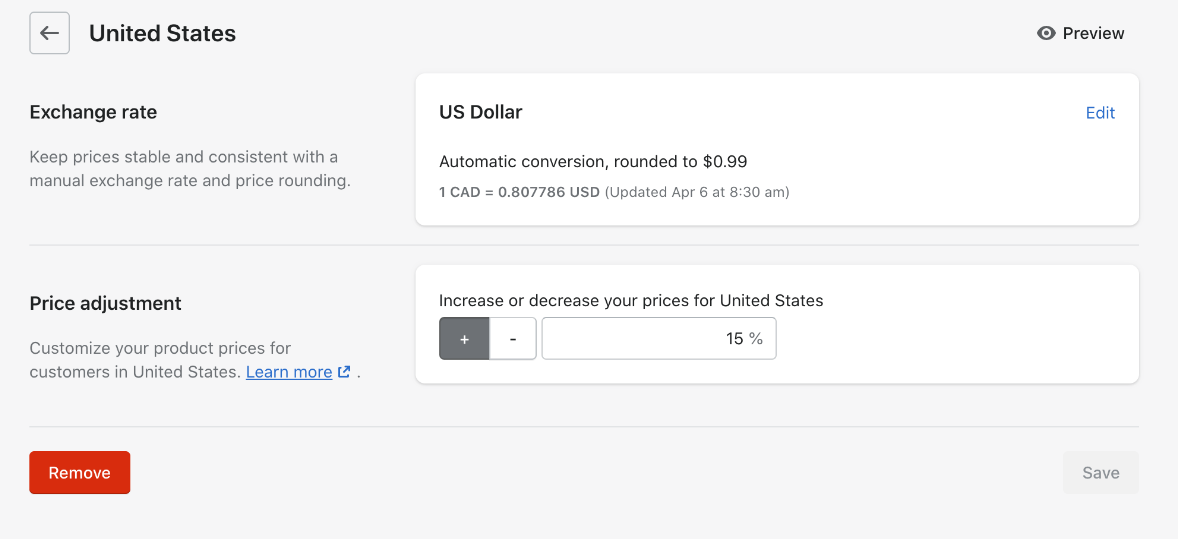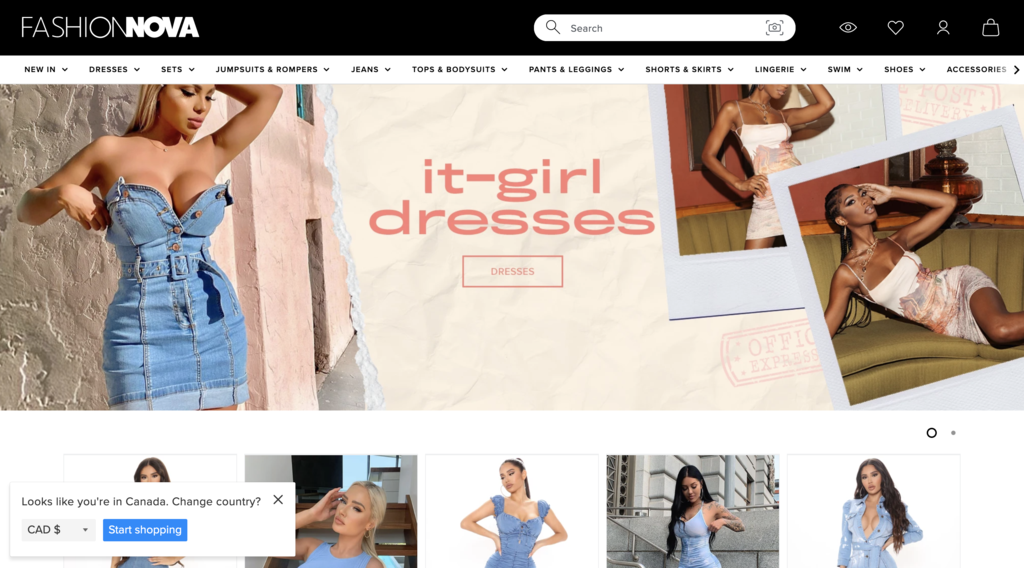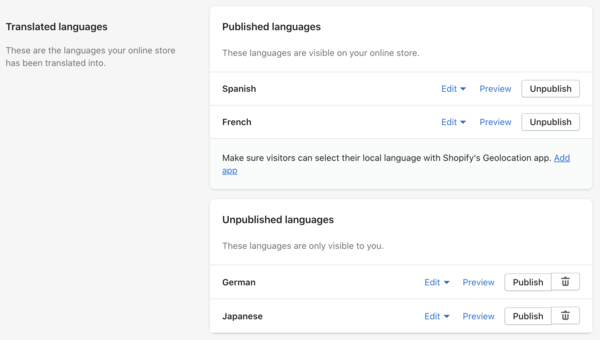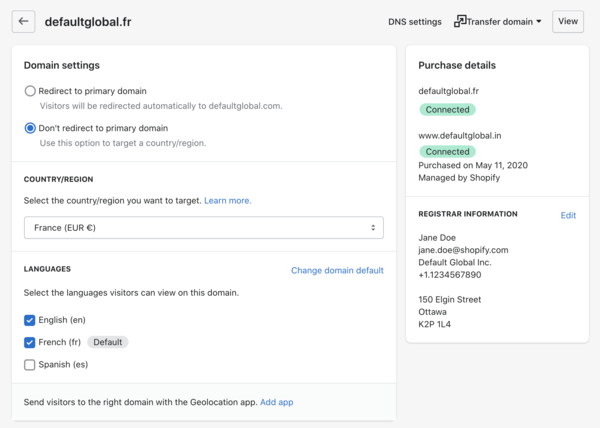According to Shopify data, 35% of all Shopify traffic comes from international visitors—and despite regulatory challenges caused by Brexit and supply chain issues caused by the pandemic, that number is predicted only to rise.
According to a 2020 study conducted by fintech research specialists Kaleido Intelligence, ecommerce cross-border sales are projected to grow by 14% annually over the next five years—outstripping domestic ecommerce growth in all regions.
But simply selling across borders isn’t enough.
To be successful in international ecommerce means diversifying your supplier networks and business relationships, navigating complex regulatory and financial hurdles, and understanding foreign trends.
Out of all the things you have to worry about, your website shouldn't be one of them. Here, we'll walk you through six features that make it easy for you to sell globally from a single shop, including:
- International pricing
- Multi-currency
- Multiple languages
- International domains
- Geolocation
- Local payment methods
1. International pricing
When you’re operating stores in multiple markets, you have to take into account regional variances like shipping, taxes, and duties, making profit margins difficult to determine.

Instead, you can use international pricing to set price adjustments by country or region.
Product prices can be adjusted by percentage or country, or you can set specific prices for your inventory, eliminating reliance on foreign exchange rates. You can also set the exchange rate manually for even greater control over your product pricing. You can even include or exclude taxes upfront based on a customer's region—helping you avoid giving your customers sticker shock.
By accounting for regional nuances like shipping, taxes, and duties (which is now more important than ever for sellers to and from the UK, thanks to Brexit’s new regulations), you can better cater to each new market.
If you’re a Shopify Plus Merchant, you can learn more by checking out this comprehensive lesson on How to go global: Creating an international pricing strategy.
2. Multi-currency
With 92% of consumers saying they have concerns about purchasing from unfamiliar websites, earning the trust of new international visitors is key. One of the easiest ways to do this is through delivering a familiar experience, including payment and delivery options.

It also applies to currency. According to Shopify research, 92% of shoppers also prefer to make purchases on sites that price in their local currency, while 33% of Shopify shoppers are likely to abandon a purchase if pricing is in US dollars only.
Stores using Shopify Payments can boost conversions and eliminate these concerns by letting customers view prices and pay for their orders in over 133 local currencies.
3. Multiple languages
You don’t have to read business journals to understand something that’s common sense: customers are most comfortable shopping in their own language.
If you do want the facts to back this up though, they’re not hard to find—one Gallup study found that 42% of Europeans never purchase products and services in a language other than their own.
But with 24 languages spoken in the EU alone, you can’t rely on shoppers to run your store through Google Translate every time they want to purchase an item.

Improve your SEO rankings, appeal to a larger audience, and help your customers have a better shopping experience by translating your store's checkout, email notifications, product information, and more into their local language. With Shopify Plus, you can sell in up to 20 languages with a supported third-party language translation app, so it won't be long before you're speaking your customer's language.
4. International domains
If a customer perceives shipping as being slow, they’re more likely to abandon their cart. In fact, one survey of nearly 1,000 American shoppers revealed that 22% leave items in their carts if they think the shipping will take too long.
One indication that shipping might be slow? When they see a domain name based overseas.

Utilizing international domains is another key aspect of localizing your website and personalizing the experience for visitors. You can expand your business to a global audience by creating shopping experiences in local languages and currencies for international customers.
This doesn’t just create a better experience for shoppers; it may also help to improve your store’s SEO ranking. With options for both domains and subdomains available, it also optimizes your site for different languages and countries, allowing you to geo target.
5. Geolocation
A 2017 Accenture study of more than 25,000 consumers globally determined that 41% of consumers switched companies over poor personalization.
For foreign customers visiting your store, it can be off-putting if the currency or language automatically defaults to American English and USD. With Geolocation services, you can avoid making a poor first impression by immediately welcoming customers to a site specific to their region or country by personalizing language and currency preferences to reflect where they’re shopping from.

No coding is required to install Shopify’s free Geolocation app in Shopify Payments. Designed to serve international customers so they can browse and buy faster, this feature offers shoppers language and country recommendations based on their geographic location or browser settings, which can be changed at any time.
This is just one more way to personalize shopping experiences across borders, which is critical to gaining your customers’ trust.
6. Local payment methods
Visiting a website that doesn’t offer your favored payment option is like arriving in a foreign country that’s largely cash-only; if you don’t have any hard cash on-hand and there are no ATMs in sight, even the simplest transactions become frustrating.
American merchants might perceive Visa, Mastercard, Amex, and PayPal as the standard forms of payment. But that’s not true for everyone. German and Austrian shoppers might expect to see EPS (electronic payment standard), a secure bank transfer payment system commonly used in both countries.
The answer is to offer local payment methods, which are direct and secure, offered in specific regions, and used by online shoppers globally. Stores using Shopify Payments can set up payments in Klarna, Sofort, iDEAL, and Bancontact, with others to be added this year. This feature also automatically shows your shoppers the most relevant local payment methods first at checkout, ensuring their shopping experience is hyper-localized.
Get started with optimizing your store for international customers
Localizing and personalizing your ecommerce site for international visitors isn’t just about building trust—it’s also about removing barriers by making the transactions frictionless.
Want to learn more? Read The Ultimate Guide to Selling Globally on Shopify.






